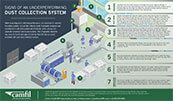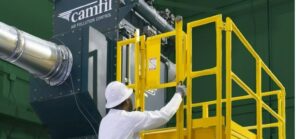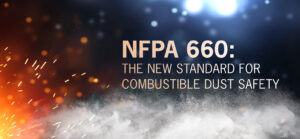During an on-site demonstration of the Gold Series Industrial Dust Collector for a customer, Camfil’s APC Taylor Morgan noticed an issue with a competitor’s dust collector across the street at another facility. He observed that the unit was letting dust bypass the fan, so he went to speak with the maintenance manager, who was unaware of the problem.
The Texas company had recently installed a 16-filter cartridge dust collector for its four-gun wire arc thermal spray application. However, the collector was already drawing too much hazardous weld smoke in the shop due to a suction problem. These issues were causing production downtime and could potentially lead to fines from the Texas Commission on Environmental Quality (TCEQ).
Addressing Undersized Equipment
The vendor of the dust collector recommended an upgrade to a 32-filter cartridge unit, and the company decided to give them a chance to fix the situation.
A month later, personnel realized that the upgrade did not solve the problems, so the maintenance manager called in Camfil to do a complete redesign with a properly sized dust collector, ductwork, and hooding tailored to the company’s processing needs.
Within six weeks, Camfil delivered a Gold Series Dust Collector equipped with ancillary systems to mitigate potential explosions, along with a guarantee that filters would last at least a year. Now, three years later, there’s been no need for replacement filters.
Watch the Full Switching Story
To get the full story, watch Taylor Morgan in this video.
Importance of Correctly Sizing the Dust Collector System
Only an appropriately sized dust collection system will effectively capture and remove airborne particles and hazards. When determining size, it is important to consider the entire system, not just the dust collector.
- Hoods must be appropriately sized to achieve the correct capture velocity. If too low, dust particles are not effectively collected. Too high and the usable product can be extracted from the process, leading to waste.
- Duct selection should ensure proper conveying velocity. If convey velocities are too low, particulates can fall into ducts and plug them, causing equipment failure and combustible events. If too high, the system uses too much energy, resulting in unneeded costs.
- Fans must be properly sized to ensure the system achieves the required airflow to collect dust. If oversized, fans draw too much air into the collector, raising the air-to-cloth ratio, shortening filter life and increasing energy costs. Undersized fans result in convey velocities that are too low, causing dust to build into the ducts.
- Filters chosen with inappropriate efficiency ratings (see MERV ratings), media and air-to-cloth ratios can result in premature failures and frequent change-outs.
- Compressed air systems with very low air pressure can result in malfunction of the filter’s pulse-clearing system .
Selecting the Right Equipment Supplier
When choosing the supplier of your dust collector, ensure they possess the knowledge to understand the requirements of designing a dust collection system that meets NFPA compliance and is sized for a particular application/facility.
As there are no formal supplier certifications, inquire about specific experience and capabilities. For example, does the supplier conduct a site survey to diagnose problems or evaluate functions such as maintaining a higher level of air cleanliness? Perhaps the facility has expanded or manufacturing processes have changed. All these parameters affect the size and capabilities of the dust collection system.
Does the manufacturer conduct in-house dust testing or work with a lab to understand the characteristics of airborne particulates? The properties of the dust or other contaminants inform decisions on dust collector specs, filter cartridges and controls to mitigate hazards.
If dust is characterized as combustible, does the manufacturer understand National Fire Protection Association (NFPA) guidelines relating to your industry? NPFA has different standards for specific industries on how to design s safe dust collection system that protects facilities against combustible dust explosions.
Get a Written Guarantee
Does the supplier provide a written guarantee of filtration efficiency and that the equipment will satisfy OSHA, EPA and other emission requirements? Different methods are used to measure filtration efficiency. MERV ratings are useful for comparing different filters, but mass density efficiency, defined as the weight per unit volume of air, is the best predictor of compliance.
As dust issues are often complex and differ by industry and process, a knowledgeable supplier can determine the best dust collector, necessary ductwork, the right filtration media and collector size and location.
Click here to learn more about how to improve dust collector performance or email ..
 Americas
Americas 




